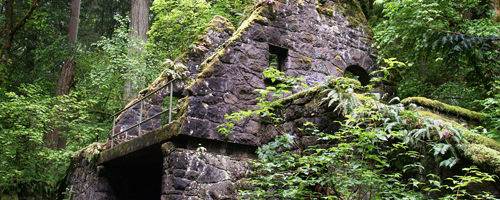No Lovecraftian tentacles peered out from the shadows as I had expected—well, hoped—except the random gnarled root sticking out from the pale, muddied earth, obstructing the trail and mocking me.
Double, double toil and trouble

No Lovecraftian tentacles peered out from the shadows as I had expected—well, hoped—except the random gnarled root sticking out from the pale, muddied earth, obstructing the trail and mocking me.
Allegedly, this part of Forest Park in Northwest Portland, Macleay Park, is home to nightly hauntings. According to Portland’s Parks and Recreation, a blood-soaked dispute between the Balch and Stump families, who lived in the area in the 19th century, resulted in two deaths.
None of the official history suggests anything witchy to explain the nickname Witch’s Castle. The rest area where the Lower Macleay Trail meets the Wildwood Trail is almost a mile from the Macleay Park entrance.
Although it’s rumored to have been the home of witches, no proof of that exists except via hearsay, poorly written blogs and ghost-hunter smartphone apps (I’ll explain later).
A plaque in the park says it best: “Near this site stood the cabin of Danford Balch…In 1859, Balch was convicted and hanged for shooting his son-in-law.”
After an escape from jail, Balch was rearrested in July of 1859 and sent to the gallows later that fall. It was the first legal public hanging in Oregon.
Radiant with ancient neon-green moss, an overhanging branch arched near-animate above the rock-riddled pathway. Just as I passed beneath it, my mind recoiled with sudden paranoia. Wind bellowed in my ear like a bemoaned spirit speaking in high-frequency ultrasonic noise.
This was only the trail to Witch’s Castle, and I was already launched full-force into some paranormal mind-funk frenzy. At least it was a free, natural high; I didn’t have to blow money on cheap beer to get in the zone.
My brain swam in my head as my ears buzzed. An invisible, clammy, toaster-oven hot hand pressed through my skull and on my amygdala—but then the creek’s soft babbling soothed the fear.
All of this happened within five to 10 seconds before I resurfaced. Rocks crunched under my feet. Muggy pockets hung in oppressive tufts as flying insects breezed by, unaffected by the sticky air. Primordial trees that once towered stories high now crisscrossed beside the trail.
At the trail intersection stood the moss-assaulted stone structure: Witch’s Castle, rumored to be the hanging site of the most nefarious Northwest witches. According to Parks and Rec, it was a bathroom built in 1929, later gutted after a hurricane destroyed it in 1962.
As I ascended the stone structure, nothing ominous stood out. It was merely an archaic ruin of past architectural aesthetics and Oregon history.
A log across from the building summoned me. I strolled over. My neck twisted to catch the view down a sharp stony decline—I’m a little acrophobic. The height wasn’t much, maybe 10 or 15 feet, but it felt like Vista “Suicide” Bridge.
One of my friends (you didn’t think I was going alone, did you?) pointed across the park and blurted out, “I wonder if that’s where ol’ boy was hanged,” half joking, half serious, and wholly and brutally inappropriate.
It wasn’t the gallows’ grounds; it was a dilapidated restroom.
Frayed rope hung overhead, from what appeared to be a Douglas fir, maybe 30 to 40 feet high. My friends were oblivious to my sweat-generating soliloquy.
After half an hour, around 9 p.m., two girls unabashedly approached Witch’s Castle, laughing, completely unafraid.
Carrie Marino, a student at Portland Community College, was showing her friend Tracie Garber the infamous hangout.
“This is my destination. Today, we were drinking, and I was like, ‘Let’s go to the fort,’” Marino said.
Without letting a full second pass, she said, “What’s the history? What’s up with this place? I feel an energy here.”
I told her I’d let her think about it for a moment, and then I said to her, “A family used to own this property.”
“Goosebumps,” Marino said, pointing at the hair standing on her forearms. “I’m pretty psychic. I keep seeing, like, two kids: a girl, a boy. There is a family. Four. Peaceful, though.”
The Balch’s had nine children, according to Parks and Rec, but whatever. Nine and four look almost alike.
“Still, I don’t feel creeped out by this place; I feel kind of whimsical about it,” Marino said.
Garber looked at Marino and said, “It’s awesome. It is like you said, it’s magical.”
Kris Lively, founder of the Portland Oregon Paranormal Society and a private investigator and corrections officer, said he didn’t know a lot about Witch’s Castle. He said it’s a hangout for teens who end up with trespassing charges.
“To be honest, real paranormal groups stay away from this place because all it really is is a rumor,” Lively said. “Most places, we can do a history, we can do a background check and actually know if there’s proof of murders, or whatever there might be. But you picked a really tough place.”
Even though he didn’t have any investigative evidence of Witch’s Castle being haunted, Lively had some top-secret ghost-hunter resources—an app he had to hang up the phone to use before calling me back—to finally reveal the origin of Witch’s Castle’s nickname.
One story that seems totally fabricated claims it’s a place where witches were hanged. The second legend at least has roots in known history, stating that Balch’s wife bewitched him.
“Which means she cursed him—you know, make him do something [with] the power of a curse,” Lively said. “So when he was hung, everybody thought it was her fault because she bewitched him. And that’s what gives it the name Witch’s Castle.”






“None of the official history suggests anything witchy to explain the nickname Witch’s Castle.”
– Back in 1850, one Danford Balch filed a claim on a parcel of land near the newly settled town of Portland. Danford needed some help clearing the land, so he hired a transient worker named Mortimer Stump. Balch invited Stump to stay with his family, which included his wife Mary Jane and their nine children, while the work was being done. Unfortunately, Stump ended up staying on a lot longer than was healthy for anyone.
It seems that Stump eventually fell in love with 15-year old Anna Balch and asked for her hand in marriage. When Danford and Mary Jane refused, the couple threatened to elope, and Father Balch retorted that if they did, he would kill Mortimer Stump. Young love being what it is, Mortimer and Anna ran off to Vancouver and were married in the fall of 1858.
Danford Balch would later claim that what happened next was the result of his wife “bewitching” him. The next time he encountered the couple, in Portland with other members of Stump’s family, a drunken Balch shot Mortimer Stump in the head. Balch was arrested, but escaped while awaiting trial. Finally arrested again six months later on his own property, he was tried, found guilty, and subsequently hanged in October of 1859, making Danford Balch the first (legal) hanging in the Oregon Territory.
Mary Jane Balch, the “Witch” in our story, continued to live on the property. To this day, some attribute the strange occurrences at the Witch’s House to the ghosts of Danford, Mortimer, Anna, and Mary Jane.
I had visited here on September 2013. I suspect that small room was use for witchcraft more likely sometime after Columbus Day Storm of 1962. There is a satanic symbol in that room and likely had been used for black magic witchcraft. Thay’s probably what started this paranormal.
Walking down the trail….my cell phone was at more than 50% power. But before we even got to the landmark at the bottom of the trail my phone battery was dead. There is no way in less than 15 minutes my phone battery goes from 50 percent power to zero.